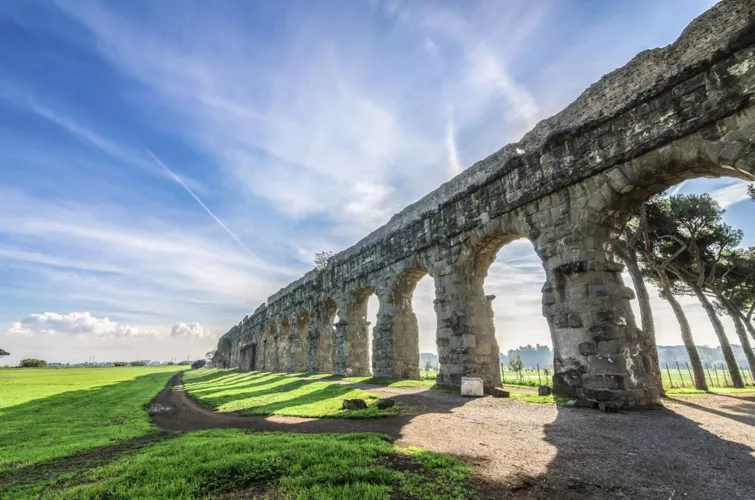This content was automatically translated. View the original text.

Overview
The Aqueduct Park on the Appian Way the place that holds the imposing arches of the water pipes built by the ancient Romans that have made the Roman landscape unique. Six of the 11 aqueducts that supplied Rome flowed into this area between the neighbourhoods of Cinecittà and Quarto Miglio, which today can be visited on foot or by bicycle on one of the city's most spectacular green slopes, dominated by the crowns of maritime pines.
6 Roman aqueducts and one Renaissance aqueduct
Grand Tour travellers, Romantic painters, archaeologists, lovers of Roman ruins and civil engineering: they all appreciated and loved this strip of Roman countryside to the south-east of the city, which preserves the remains of six Roman aqueducts, as well as one Renaissance aqueduct, with their imposing geometric arches interrupted by the roundness of the canopies of maritime pines. The Aqueduct Park was included in the Appian Way Park in 1988 to protect a landscape of great historical and architectural value. We owe it to the initiative of a civic committee if today we can walk among such beauty, in an area rescued from degradation and for the purpose of constructing speculation.
Anio Vetus, the oldest
From 312 BC and for several centuries, Rome's springs were supplied with clean and safe water through the construction of imposing pipelines that brought into the city water drawn from the Latium mountains. The water of the Tiber was not adequate to respond to the needs of an increasingly populated city: hence the need to supply further afield, met thanks to these impressive hydraulic engineering works that characterised the history of the Roman Empire.
The remains of the aqueducts that flow into the area are those of Anio Vetus (underground, it is the oldest and has a length of 64 km), Aqua Marcia, Tepula, Julia, Claudio and Anio Novus, which partly overlap, and Felice, built by Pope Sixtus V between 1585 and 1590 to supply some Roman neighbourhoods that had run dry due to the decay of the older aqueducts during the Middle Ages; the latter is still used to irrigate the countryside. The water of the aqueducts mostly flowed underground, but when it had to cross a valley, the pipes had to be supported by masonry arches.
Picnics, drinking fountains and bicycles
The vast 240-hectare area of the Aqueducts Park is closed to traffic and criss-crossed by various paths that can be walked or cycled every day. In the area there are picnic areas (but barbecuing is prohibited), drinking fountains, a bicycle rental service (open on Sundays), as well as a few bars and restaurants.
The park can also be reached from the centre of Rome by metro, from Porta Furba stop, where there is an information point, and at the following stops, up to Cinecittà.
In Rome, do as the Romans do, who go there at sunset, when the grazing light illuminates the arches with a magical glow.